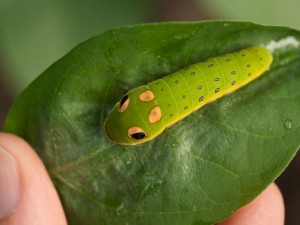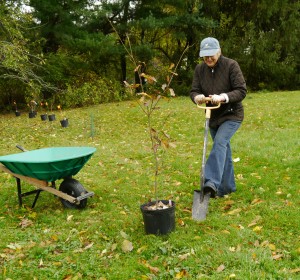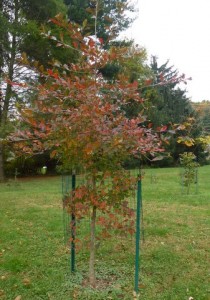By Edie Parnum
I thrust my spade into a patch of my lawn. It’s fall, and I’m planting a 4-foot Chestnut Oak. As I dig, I imagine this young tree next spring with its new green leaves. Even as a young sapling, it will host insects and birds. Looking into the future, I imagine this stately native tree a century from now. It has given life to thousands of birds and other animals.
My neighbors, I’ve noticed, aren’t thinking about spring. They are clearing their yards of leaves and the dead vegetation from last year’s ornamental plants. They are putting this unwanted garden debris out on the curb along with the cocoons and eggs of next year’s insects. They are getting ready for winter. Fall is the best time for planting trees and shrubs, any time before the ground freezes. During the autumn rains, the new plants aren’t asleep. They’re putting energy into their roots for a spurt of growth next spring.This fall, as usual, I will plant several trees and shrubs. When I bought this ¾-acre property five years ago, it was mostly grass with just a few trees, mostly non-natives. Since then I’ve planted 39 native trees and 45 native shrubs. It’s still not enough.
I keep planting native woody plants because they support wildlife. Certainly non-native woodies offer fruits birds will eat—witness the bird-spread proliferation of invasives like Multiflora Rose, Burning Bush, and Japanese Barberry. Natives, however, offer fruits of optimum size and superior nutrition. The fruits of the dogwoods, blueberries, winterberries, viburnums, spicebush, and sassafras I’ve planted ripen just in time to nourish hungry migrating birds in fall. Now in late October most of the berries are gone—consumed by thrushes, catbirds, mockingbirds, waxwings, and warblers.
The main reason I plant native woodies, however, is for the caterpillars and other insects these plants support. I’m inspired by Doug Tallamy, Professor and Chair of Entomology and Wildlife Ecology at the University of Delaware. His research shows

The caterpillar of the Spicebush Swallowtail butterfly uses Spicebush or Sassafras as its host plant. USFWS Photo by Ryan Hagerty.
that native plants host 29 times more of the native insects essential for our birds. After all, 96% of terrestrial birds feed their young exclusively insect food.
This year to augment what I’m already growing, I’ll plant ten small trees and shrubs. I’m planting the Chestnut Oak, Quercus prinus (according to Tallamy, oaks host 534 species of caterpillars); American Elm, Ulmus Americana (hosts 213); and Pawpaw, Asimina triloba (host plant for Zebra Swallowtail butterfly, a species I covet for my yard butterfly list).
Planting a tree or shrub is easy. For my Chestnut Oak and the other trees and shrubs, I don’t need to dig a huge hole. I make my hole only as deep as the soil in the plant container and twice as wide. After putting the plant into the hole, I make sure the soil line of the plant is level with the ground. Then I use the soil that was removed from the hole to fill in around the plant. Because my oak is a local native adapted to our soil, I am not tempted to add special topsoil, fertilizer, or any other enrichment. That would stimulate fast but weak growth. A hole filled with artificially enriched soil encourages the roots to stay confined rather than to reach into the ground below for nourishment. Next, I push down on the loose dirt with my hands, but avoid stomping on it with my feet. I spread a one-inch layer of my compost (last year’s leaves and garden debris) on top to provide some extra humus not available in the turf grass. Then I give my oak a good watering. That’s it for this tree. I’m ready to plant more.
Newly planted trees and shrubs may need extra water. During any week without significant rain, I put a leaky watering can next to each plant and let the water drip slowly into the soil. A 1-2” layer of mulch will help retain the moisture, but I never let the mulch touch the trunk. Once established, these woody plants, situated appropriately for light and moisture, should thrive without any additional help from me.
The trees and shrubs I plant are usually small. They are cheaper and suffer less transplant shock than a big tree or shrub. These smaller saplings start to grow more quickly and in a few years usually out-compete larger nursery stock. To save money, I also frequently transplant volunteer trees and shrubs in my yard to more appropriate locations. Some of my shrubs—virburnums, for instance—send out shoots that I dig up and plant elsewhere. I also accept gifts from my native plant gardening friends. As I say, there’s always room for more. Anyway, I’m not growing ornamental specimens. The plants can touch each other and offer extra shelter, just as they do in the wild.
My trees and shrubs are still small, but they already support birds and other wildlife. Next spring I’ll see warblers and other hungry migrants eating caterpillars on the leaves of my native woody plants. The remaining areas of grass are begging to be planted with additional native trees and shrubs. Next fall I won’t resist planting more.
—————————–
For Doug Tallamy’s list of woody plants supporting butterfly and moth caterpillars, click here.
| Trees and Shrubs on Edie’s Property | ||
| Botanical Name | Common Name | Wildlife Value |
| Trees | ||
| Acer rubrum | Red Maple | L, F |
| Aesculus pavia | Red Buckeye | L, N |
| Amelanchier canadensis | Serviceberry/ Juneberry | L. F |
| Asimina triloba | Pawpaw | L, F |
| Betula lenta, B. nigra | Sweet Birch, River Birch | L, F |
| Celtis occidentalis | Hackberry | L, F |
| Cercis canadensis | Eastern Redbud | L, N |
| Cornus alternifolia, C.florida | Pagoda Dogwood, Flowering Dogwood | L, F |
| Ilex opaca | American Holly | L, F |
| Juniperus virginiana | Eastern Red Cedar | L, F |
| Liriodendron tulipifera | Tulip Poplar | L, N, F |
| Magnolia virginiana | Sweetbay Magnolia | L |
| Nyssa sylvatica | Black Gum/ Tupelo | L, F |
| Pinus strobus | Eastern White Pine | L, F |
| Prunus serotina | Black Cherry | L, F |
| Quercus alba,Q. coccinea, Q. pinus, Q. rubra | White Oak, Scarlet Oak, Chestnut Oak, Red Oak | L, F |
| Sassafras albidum | Sassafras | L, F |
| Tsuga canadensis | Eastern Hemlock | L,F |
| Shrubs | ||
| Aronia melanocarpa. | Black Chokeberry | L, F |
| Clethra alnifolia | Sweet Pepperbush | N |
| Cornus racemosa, C. amonum | Gray Dogwood, Silky Dogwood | L, N, F |
| Hydrangea arborescens, H. quercifolia | Wild Hydrangea, Oakleaf Hydrangea | N |
| Ilex verticillata | Winterberry Holly | F |
| Myrica pensylvanica | Bayberry | L, F |
| Rosa virginiana | Wild or Pasture Rose | L, F |
| Sambucus canadensis | American Elder | L, F, N |
| Vaccinium corymbosum | Highbush Blueberry | L, F, N |
| Viburnum dentatum, V. lentago,V. nudum, V. prunifolium | Arrowwood Viburnum, Nannyberry, Possumhaw, Black Haw | L, F |
| L = Leaves support moth and butterfly caterpillars and other leaf-eating insects that are eaten by birds | ||
| N = Nectar for hummingbirds, butterflies, and other pollinators | ||
| F = Food products such as berries, seeds, nuts, buds, and pollen for birds, mammals, and pollinators | ||
Places to buy native plants:
- Edge of the Woods Nursery
- Gateway Gardens
- Jenkins Arboretum
- Redbud Native Plant Nursery
- Yellow Springs Farm




Hi,
Edie,
I think I’m ready to plant my first oak, which do you suggest?
robb
PS Jeff and I are doing a winter vine talk this Saturday at Heinz from 9-12 if you can make it.
Robb,
I love it. You are planning to plant an oak. Which kind? As you probably already know, oaks are divided into the red oaks and white oaks. In general red oaks ((Black, Red, and Scarlet Oaks) grow faster but are more susceptible to fungal diseases. White oaks (White and Chestnut Oaks) are less likely to get diseased but grow slowly. All are beautiful trees. Oaks are eventually very large, so hope you have space. You are one of the few people I know who can recite the number of lepidoptera hosted by oaks according to Doug Tallamy–534! Your oak will have high wildlife value for birds and other creatures for years to come.
Edie
Wonderful write up Edie. The birds and butterflies will thank you with their presence.
Dear Edie
This story is as grounding as the roots of your sapling. It refreshed my memory of what seems like months ago this year when I planted a Redbud, a River birch, a native rose bush, and some Mountain mint. It affirmed me to be patient and happy giving home to the invisible. It taught me again the way to plant a tree, I am grateful for that. It reminded me to take regular time to feel the connection and the staying power of nature. Keep them stories coming…
Ana
Hi, Edie:
Because of your inspiring blog, I am introducing native perennials and shrubs to my small, suburban garden. I’ll put a copy of your article in my garden file and follow its step by step instructions. I have been doing EVERYTHING wrong: digging a huge hole, surrounding the roots with “artificially enriched” soil, stomping on the soil, etc. I love the tip about the leaky watering can!
Your writing reflects your knowledge and passion!
Wendy
Excellent article, Edie. You called attention to the fact that so many of our neighbors are cleaning their yards and putting last year’s vegetation out for the trash. Do you or any of your readers have suggestions of how we can convince our neighbors not to do that? It just seems so logical to me to leave a layer of leaves on our non-grassy areas and to rake and compost the leaves that fall on our driveway and save them for next spring. I see others blowing the ground completely bare around woody plants and ferns. We explain what we are doing and why, but we are labeled as being unkempt instead of as good stewards of the land. It’s frustrating to me.
Mary Ellen,
You bring up a problem that’s difficult to solve. How can you persuade your neighbors to allow their leaves to remain on the ground, even in inconspicuous areas? It’s impossible if they’re inclined to garden solely for aesthetics and without regard to negative effects on the environment. A high-minded lecture, even with your most convincing arguments, probably won’t work and could be counterproductive.
If they like nature at all, they may respond to a suggestion to plant some pretty native plants. A small native tree like Eastern Redbud, Flowering Dogwood, or River Birch is pleasing to everyone. Native perennials such as Butterfly Weed (Orange Milkweed for a more appealing name), Coneflower, and New England Aster are widely admired. Could you give them some extra native plants from your yard? What about inviting your neighbors’ children over to see your butterflies, nesting birds, or even some cool insects? Perhaps you could host a barbecue for your neighbors and then show them the beauties and wonders of your property.
Of course, a well-maintained and aesthetically pleasing front yard helps to promote neighborly good will. After all, with good reason my Co-Director, Barb Elliot, and I call our program Backyards for Nature.
Edie Parnum